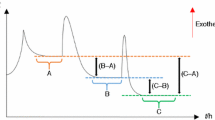Abstract
For the culture of normal and transformed fibroblasts, the differential effect of two nanoclusters (Мо72Fe30, Мо132) has been shown. The Мо72Fe30 nanocluster is nontoxic to normal fibroblasts, while the Мо132 cluster shows toxicity to normal and transformed fibroblasts. An analysis of the ultrastructure of the cells under the influence of the nanoclusters has demonstrated the specificity of the changes. The dermal fibroblasts are more resistant to the action of Мо72Fe30; the Мо132 cluster causes extensive disorders in the membrane organelles both in normal and transformed fibroblasts. The results confirm the possibility of applying the Мо72Fe30 nanocluster in biomedicine and the use of the Мо132 nanocluster in oncology.
Similar content being viewed by others
References
A. Müller, E. Krickemeyer, H. Bögge, M. Schmidtmann, and F. Peters, “Organizational forms of matter: an inorganic superfullerene and keplerate based on molybdenum oxide,” Angew. Chem., Int. Ed. Engl. 37, 3360–3363 (1998).
A. Müller, V. P. Fedin, C. Kuhlmann, H. Bögge, and M. Schmidtmann, “A hydrogen-bonded cluster with ‘onion-type’ structure, encapsulated and induced by a spherical cluster shell: [(H2O)nMoVI 72MoV 60O372(HCO2)30(H2O)72]42-,” Chem. Commun., No. 10, 927–929 (1999).
A. Müller, S. Sarkar, S. Q. N. Shah, H. Bögge, M. Schmidtmann, S. Sarkar, P. Kögerler, B. Hauptfleisch, A. X. Trautwein, and V. Schunemann, “Archimedian synthesis and magic numbers: “Sizing” giant molybdenum—oxide based molecular spheres of the keplerate type,” Angew. Chem., Int. Ed. Engl. 38, 3238–3241 (1999).
A. A. Ostroushko, I. F. Gette, S. Yu. Medvedeva, M. O. Tonkushina, I. G. Danilova, A. V. Prokof’eva, and M. V. Morozova, “Estimation of safety of ferromolybdenum nanocluster polyoxometalates intended for address delivery of medicines,” Vestn. Ural. Med. Akad. Nauki 34, 107–110 (2011).
A. A. Ostroushko, I. G. Danilova, I. F. Gette, S. Yu.Medvedeva, M. O. Tonkushina, A. V. Prokofieva, and M. V. Morozova, “Study of safety of molybdenum and iron-molybdenum nanocluster polyoxometalates intended for targeter delivery of drugs,” J. Biomater. Nanobiotechnol., No. 2, 557–560 (2011).
A. A. Ostroushko, I. F. Gette, S. Yu. Medvedeva, I. G. Danilova, E. A. Mukhlynina, M. O. Tonkushina, and M. V. Morozova, “Study of acute and subacute action of iron-molybdenum nanocluster polyoxometalates,” Nanotechnol. Russ. 8, 672–677 (2013).
A. A. Ostroushko, I. G. Danilova, S. Yu. Medvedeva, I. F. Gette, and M. O. Tonkushina, “Studying of safety of molybden nanocluster polyoxometalates intended for address delivery of medicinal substances,” Ural. Med. Zh., No. 9, 114–117 (2010).
A. A. Ostroushko, I. F. Gette, I. G. Danilova, E. A. Mukhlynina, M. O. Tonkushina, and K. V. Grzhegorzhevskii, “Studies on the possibility of introducing iron-molybdenum buckyballs into an organism by electrophoresis,” Nanotechnol. Russ. 9, 577–582 (2014).
A. A. Ostroushko, I. G. Danilova, I. F. Gette, and M. O. Tonkushina, “Behavior of associates of keplerate type porous spherical Mo72Fe30 clusters with metal cations in electric field driven ion transport,” Russ. J. Inorg. Chem. 60, 500–504 (2015).
I. D. Gagarin, A. A. Ostroushko, K. V. Grzhegorzhevskii, and M. O. Tonkushina, “Electrophoretic delivery of Mo72Fe30 nanocluster,” in Proceedings of the 7th International Congress on Nanotechnogy in Medicine and Biology BioNanoMed 2016, Apr. 6–8, 2016, Krems, Austria (Donau Univ., Krems, 2016), p. 23.
A. A. Ostroushko, I. D. Gagarin, M. O. Tonkushina, K. V. Grzhegorzhevskii, I. F. Gette, S. Yu. Medvedeva, E. A. Mukhlynina, M. V. Ulitko, and I. G. Danilova, “Promising means of targeted delivery of medical product on the basis of nanocluster polyoxometalates,” in Proceedings of the 20th Mendeleev Congress on General and Applied Chemistry (Ross. Akad. Nauk, Yekaterinburg, 2016), Vol. 4, p. 511.
I. G. Danilova, I. F. Gette, S. Yu. Medvedeva, A. V. Belousova, M. O. Tonkushina, and A. A. Ostroushko, “Influence of iron-molybdenum nanocluster polyoxometalates on the apoptosis of blood leukocytes and the level of heat-shock proteins in the cells of thymus and spleen in rats,” Nanotechnol. Russ. 11, 653–662 (2016).
T. Yamase, “Polyoxometalates for molecular devices: Antitumor activity and luminescence,” Mol. Eng., No. 3, 241–262 (1993).
T. Yamase, “Antitumoral and antiviral polyoxometalates (inorganic discrete polymer of metal oxide),” in The Polymeric Materials Encyclopedia. Synthesis, Prop erties and Applications, Ed. by J. C. Salamone (CRC, Boca Raton, FL, 1996), Vol. 1, pp. 365–373.
H. Yanagiea, A. Ogatab, S. Mitsui, T. Hisa, T. Yamase, and M. Eriguchi, “Anticancer activity of polyoxomolybdate,” Biomed. Pharm. 60, 349–352 (2006).
I. G. Danilova, I. F. Gette, S. Yu. Medvedeva, E. A. Mukhlynina, M. O. Tonkushina, and A. A. Ostroushko, “Changing the content of histone proteins and heat-shock proteins in the blood and liver of rats after the single and repeated administration of nanocluster iron-molybdenum polyoxometalates,” Nanotechnol. Russ. 10, 820–826 (2015).
A. A. Ostroushko, M. O. Tonkushina, V. Yu. Korotaev, A. V. Prokof’eva, I. B. Kutyashev, V. A. Vazhenin, I. G. Danilova, and S. Yu. Men’shikov, “Stability of the Mo72Fe30 polyoxometalate buckyball in solution,” Russ. J. Inorg. Chem. 57, 1210–1213 (2012).
A. A. Ostroushko and M. O. Tonkushina, “Destruction of molybdenum nanocluster polyoxometallates in aqueous solutions,” Russ. J. Phys. Chem. A 89, 443–446 (2015).
M. L. Kistler, T. Liu, P. Gouzerh, A. M. Todea, and A. Müller, “Molybdenum-oxide based unique polyprotic nanoacids showing different deprotonations and related assembly processes in solution,” Dalton Trans., 5094–5100 (2009).
M. V. Berridge, P. M. Herst, and A. S. Tan, “Tetrazolium dyes as tools in cell biology: New insights into their cellular reduction,” Biotechnol. Ann. Rev. 11, 127–152 (2005).
H. Tominaga, M. Ishiyama, F. Ohseto, K. Sasamoto, T. Hamamoto, K. Suzuki, and M. Watanabe, “A watersoluble tetrazolium salt useful for colorimetric cell viability assay,” Anal. Commun. 36, 47–50 (1999).
Author information
Authors and Affiliations
Corresponding author
Additional information
Original Russian Text © A.A. Ostroushko, M.V. Ulitko, M.O. Tonkushina, I.V. Zubarev, S.Yu. Medvedeva, I.G. Danilova, O.V. Gubaeva, I.D. Gagarin, I.F. Gette, 2018, published in Rossiiskie Nanotekhnologii, 2018, Vol. 13, Nos. 1–2.
Rights and permissions
About this article
Cite this article
Ostroushko, A.A., Ulitko, M.V., Tonkushina, M.O. et al. Influence of Nanocluster Molybdenum Polyoxometalates on the Morphofunctional State of Fibroblasts in Culture. Nanotechnol Russia 13, 1–10 (2018). https://doi.org/10.1134/S199507801801010X
Received:
Accepted:
Published:
Issue Date:
DOI: https://doi.org/10.1134/S199507801801010X




